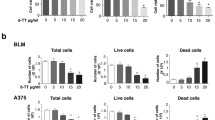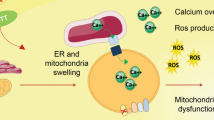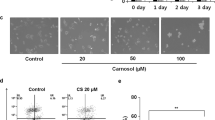Abstract
Introduction
Resistance to apoptosis is a prominent feature of melanoma. Pharmacological concentration of arsenic in combination with a widely known oxidant, menadione was explored in this study to synergistically sensitize malignant melanoma cells to apoptosis. The molecular mechanism of apoptosis and the signaling-pathways involved were thoroughly investigated.
Materials methods and results
Menadione synergized NaAsO2 to significantly increase ROS generation and facilitate the major apoptotic signaling events: alteration of mitochondrial membrane potential, cytochrome c release and anti-apoptotic protein Bcl-2 down-regulation and subsequent activation of caspase-9 and caspase-3 followed by poly-ADP-ribose polymerase-1 cleavage. Antioxidant N-acetyl-l-cysteine antagonized these events. Investigation of the signaling-pathway revealed significant suppression of AP-1 activity but not NF-κB upon NaAsO2 and menadione application. An increase in p38 phosphorylation and p53 protein expression did also dictate the apoptotic response. Suppression of p38 activation with SB203580 and inhibition of p53 expression by siRNA attenuated apoptosis. Transfection of p53, in p53 null HCT cells augmented the apoptotic events. Moreover, the treatment also led to tumor size reduction in BALB/c mice developed by intra-dermal B16 mouse melanoma cell injection; however, it had no detectable pro-proliferative or pro-apoptotic effect on non-tumor keratinocytes, normal fibroblasts or PBMC.
Conclusion
This study thus provides an insight into innovative mechanisms of melanoma sensitization, a proper cure against which is still elusive. Taken together, our data also provides the first evidence of arsenic activity accentuation by menadione through modulation of specific signaling-pathways.







Similar content being viewed by others
References
Jurcic JG, Soignet SL, Maslak AP (2007) Diagnosis and treatment of acute promyelocytic leukemia. Curr Oncol Rep 9:337–344. doi:10.1007/s11912-007-0045-9
Chou WC, Dang CV (2005) Acute promyelocytic leukemia: recent advances in therapy and molecular basis of response to arsenic therapies. Curr Opin Hematol 12:1–6. doi:10.1097/01.moh.0000148552.93303.45
Cheung WM, Chu PW, Kwong YL (2007) Effects of arsenic trioxide on the cellular proliferation, apoptosis and differentiation of human neuroblastoma cells. Cancer Lett 246:122–128. doi:10.1016/j.canlet.2006.02.009
Shen ZY, Zhang Y, Chen JY et al (2004) Intratumoral injection of arsenic to enhance antitumor efficacy in human esophageal carcinoma cell xenografts. Oncol Rep 11:155–159
Huang RQ, Gao SF, Wang WL, Staunton S, Wang G (2006) Soil arsenic availability and the transfer of soil arsenic to crops in suburban areas in Fujian Province, southeast China. Sci Total Environ 368:531–541. doi:10.1016/j.scitotenv.2006.03.013
Bode AM, Dong Z (2002) The paradox of arsenic: molecular mechanisms of cell transformation and chemotherapeutic effects. Crit Rev Oncol Hematol 42:5–24. doi:10.1016/S1040-8428(01)00215-3
Engel RH, Evens AM (2006) Oxidative stress and apoptosis: a new treatment paradigm in cancer. Front Biosci 11:300–312. doi:10.2741/1798
Kang YH, Yi MJ, Kim MJ et al (2004) Caspase-independent cell death by arsenic trioxide in human cervical cancer cells: reactive oxygen species-mediated poly(ADP-ribose) polymerase-1 activation signals apoptosis-inducing factor release from mitochondria. Cancer Res 64:8960–8967. doi:10.1158/0008-5472.CAN-04-1830
Yang J, Li H, Chen YY et al (2004) Anthraquinones sensitize tumor cells to arsenic cytotoxicity in vitro and in vivo via reactive oxygen species-mediated dual regulation of apoptosis. Free Radic Biol Med 37:2027–2041. doi:10.1016/j.freeradbiomed.2004.09.016
Yi J, Yang J, He R et al (2004) Emodin enhances arsenic trioxide-induced apoptosis via generation of reactive oxygen species and inhibition of survival signaling. Cancer Res 64:108–116. doi:10.1158/0008-5472.CAN-2820-2
Kassouf W, Highshaw R, Nelkin GM, Dinney CP, Kamat AM (2006) Vitamins C and K3 sensitize human urothelial tumors to gemcitabine. J Urol 176:1642–1647. doi:10.1016/j.juro.2006.06.042
Hitomi M, Yokoyama F, Kita Y et al (2005) Antitumor effects of vitamins K1, K2 and K3 on hepatocellular carcinoma in vitro and in vivo. Int J Oncol 26:713–720
Thor H, Smith MT, Hartzell P, Bellomo G, Jewell SA, Orrenius S (1982) The metabolism of menadione (2-methyl-1, 4-naphthoquinone) by isolated hepatocytes A study of the implications of oxidative stress in intact cells. J Biol Chem 257:12419–12425
Ivanov VN, Bhoumik A, Ronai Z (2003) Death receptors and melanoma resistance to apoptosis. Oncogene 22:3152–3161. doi:10.1038/sj.onc.1206456
Soengas MS, Lowe SW (2003) Apoptosis and melanoma chemoresistance. Oncogene 22:3138–3151. doi:10.1038/sj.onc.1206454
Serrone L, Zeuli M, Sega FM, Cognetti F (2000) Dacarbazine-based chemotherapy for metastatic melanoma: thirty-year experience overview. J Exp Clin Cancer Res 19:21–34
Tsao H, Atkins MB, Sober AJ (2004) Management of cutaneous melanoma. N Engl J Med 351:998–1012. doi:10.1056/NEJMra041245
Kim KB, Bedikian AY, Camacho LH, Papadopoulos NE, McCullough C (2005) A phase II trial of arsenic trioxide in patients with metastatic melanoma. Cancer 104:1687–1692
Panka DJ, Atkins MB, Mier JW (2006) Targeting the mitogen-activated protein kinase pathway in the treatment of malignant melanoma. Clin Cancer Res 12:2371s–2375s. doi:10.1158/1078-0432.CCR-05-2539
Chowdhury R, Dutta A, Chaudhuri SR, Sharma N, Giri AK, Chaudhuri K (2008) In vitro and in vivo reduction of sodium arsenite induced toxicity by aqueous garlic extract. Food Chem Toxicol 46:740–751. doi:10.1016/j.fct.2007.09.108
Miller WH Jr, Schipper HM, Lee JS, Singer J, Waxman S (2002) Mechanisms of action of arsenic trioxide. Cancer Res 62:3893–3903
Green LC, Wagner DA, Glogowski J, Skipper PL, Wishnok JS, Tannenbaum SR (1982) Analysis of nitrate, nitrite, and [15N] nitrate in biological fluids. Anal Biochem 126:131–138. doi:10.1016/0003-2697(82)90118-X
Aebi H (1984) Catalase in vitro. Methods Enzymol 105:121–126. doi:10.1016/S0076-6879(84)05016-3
Misra HP, Fridovich I (1972) The role of superoxide anion in the autoxidation of epinephrine and a simple assay for superoxide dismutase. J Biol Chem 247:3170–3175
Wilber CG, Del Pomo M (1949) Comparative study of lipids in whole carcasses of Arctic and non-Arctic fish. Proc Soc Exp Biol Med 72:418–420
Haraguchi M, Torii S, Matsuzawa S et al (2000) Apoptotic protease activating factor 1 (Apaf-1)-independent cell death suppression by Bcl-2. J Exp Med 191:1709–1720. doi:10.1084/jem.191.10.1709
Lazebnik YA, Kaufmann SH, Desnoyers S, Poirier GG, Earnshaw WC (1994) Cleavage of poly(ADP-ribose) polymerase by a proteinase with properties like ICE. Nature 371:346–347. doi:10.1038/371346a0
Hayashi T, Hideshima T, Akiyama M et al (2002) Arsenic trioxide inhibits growth of human multiple myeloma cells in the bone marrow microenvironment. Mol Cancer Ther 1:851–860
McNeely SC, Belshoff AC, Taylor BF et al (2008) Sensitivity to sodium arsenite in human melanoma cells depends upon susceptibility to arsenite-induced mitotic arrest. Toxicol Appl Pharmacol 229:252–261. doi:10.1016/j.taap.2008.01.020
McNeely SC, Taylor BF, States JC (2008) Mitotic arrest-associated apoptosis induced by sodium arsenite in A375 melanoma cells is BUBR1-dependent. Toxicol Appl Pharmacol 231:61–67. doi:10.1016/j.taap.2008.03.020
Nordenson I, Beckman L (1991) Is the genotoxic effect of arsenic mediated by oxygen free radicals? Hum Hered 41:71–73. doi:10.1159/000153979
Liu SX, Athar M, Lippai I, Waldren C, Hei TK (2001) Induction of oxyradicals by arsenic: implication for mechanism of genotoxicity. Proc Natl Acad Sci USA 98:1643–1648. doi:10.1073/pnas.031482998
Liu X, Kim CN, Yang J, Jemmerson R, Wang X (1996) Induction of apoptotic program in cell-free extracts: requirement for dATP and cytochrome c. Cell 86:147–157. doi:10.1016/S0092-8674(00)80085-9
Alnemri ES, Livingston DJ, Nicholson DW et al (1996) Human ICE/CED-3 protease nomenclature. Cell 87:171. doi:10.1016/S0092-8674(00)81334-3
Soengas MS, Capodieci P, Polsky D et al (2001) Inactivation of the apoptosis effector Apaf-1 in malignant melanoma. Nature 409:207–211. doi:10.1038/35051606
Sun Y, Orrenius S, Pervaiz S, Fadeel B (2005) Plasma membrane sequestration of apoptotic protease-activating factor-1 in human B-lymphoma cells: a novel mechanism of chemoresistance. Blood 105:4070–4077. doi:10.1182/blood-2004-10-4075
Leaman DW, Chawla-Sarkar M, Vyas K et al (2002) Identification of X-linked Inhibitor of Apoptosis-associated Factor-1 as an Interferon-stimulated Gene That Augments TRAIL Apo2L-induced Apoptosis. J Biol Chem 277:28504–28511. doi:10.1074/jbc.M204851200
Hsu TC, Young MR, Cmarik J, Colburn NH (2000) Activator protein 1 (AP-1)- and nuclear factor kappaB (NF-kappaB)-dependent transcriptional events in carcinogenesis. Free Radic Biol Med 28:1338–1348. doi:10.1016/S0891-5849(00)00220-3
Mathas S, Lietz A, Janz M et al (2003) Inhibition of NF-kappaB essentially contributes to arsenic-induced apoptosis. Blood 102:1028–1034. doi:10.1182/blood-2002-04-1154
Zhou LF, Zhu Y, Cui XF, Xie WP, Hu AH, Yin KS (2006) Arsenic trioxide, a potent inhibitor of NF-kappaB, abrogates allergen-induced airway hyper responsiveness and inflammation. Respir Res 7:146. doi:10.1186/1465-9921-7-146
Bulavin DV, Saito S, Hollander MC et al (1999) Phosphorylation of human p53 by p38 kinase coordinates N-terminal phosphorylation and apoptosis in response to UV radiation. EMBO J 18:6845–6854. doi:10.1093/emboj/18.23.6845
Yu J, Qian H, Li Y et al (2007) Arsenic trioxide (As2O3) reduces the invasive and metastatic properties of cervical cancer cells in vitro and in vivo. Gynecol Oncol 106:400–406. doi:10.1016/j.ygyno.2007.04.016
Baysan A, Yel L, Gollapudi S, Su H, Gupta S (2007) Arsenic trioxide induces apoptosis via the mitochondrial pathway by upregulating the expression of Bax and Bim in human B cells. Int J Oncol 30:313–318
Woo SH, Park IC, Park MJ et al (2002) Arsenic trioxide induces apoptosis through a reactive oxygen species-dependent pathway and loss of mitochondrial membrane potential in HeLa cells. Int J Oncol 21:57–63
Burdon RH (1996) Control of cell proliferation by reactive oxygen species. Biochem Soc Trans 24:1028–1032
Criddle DN, Gillies S, Baumgartner-Wilson HK et al (2006) Menadione-induced reactive oxygen species generation via redox cycling promotes apoptosis of murine pancreatic acinar cells. J Biol Chem 281:40485–40492. doi:10.1074/jbc.M607704200
Finkel T (2001) Reactive oxygen species and signal transduction. IUBMB Life 52:3–6. doi:10.1080/15216540252774694
Sauer H, Wartenberg M, Hescheler J (2001) Reactive oxygen species as intracellular messengers during cell growth and differentiation. Cell Physiol Biochem 11:173–186. doi:10.1159/000047804
Levkau B, Scatena M, Giachelli CM, Ross R, Raines EW (1999) Apoptosis overrides survival signals through a caspase-mediated dominant-negative NF-kappa B loop. Nat Cell Biol 1:227–233. doi:10.1038/12050
Karin M, Lin A (2002) NF-kappaB at the crossroads of life and death. Nat Immunol 3:221–227. doi:10.1038/ni0302-221
Keller D, Zeng X, Li X et al (1999) The p38 MAPK inhibitor SB203580 alleviates ultraviolet-induced phosphorylation at serine 389 but not serine 15 and activation of p53. Biochem Biophys Res Commun 261:464–471. doi:10.1006/bbrc.1999.1023
Huang C, Ma WY, Li J, Dong Z (1999) Arsenic induces apoptosis through a c-Jun NH2-terminal kinase-dependent, p53-independent pathway. Cancer Res 59:3053–3058
Huang C, Ma WY, Li J, Goranson A, Dong Z (1999) Requirement of Erk, but not JNK, for arsenite-induced cell transformation. J Biol Chem 274:14595–14601. doi:10.1074/jbc.274.21.14595
Huang C, Ma WY, Maxiner A, Sun Y, Dong Z (1999) p38 kinase mediates UV-induced phosphorylation of p53 protein at serine 389. J Biol Chem 274:12229–12235. doi:10.1074/jbc.274.18.12229
Acknowledgments
The study is supported by grants (CMM-0003, CMM-0016 and IAP-0001) and research fellowships (R.C., S·C. and P·C.) from Council of Scientific and Industrial Research (CSIR) and University of Grant Commission (UGC) Government of India.
Author information
Authors and Affiliations
Corresponding author
Rights and permissions
About this article
Cite this article
Chowdhury, R., Chowdhury, S., Roychoudhury, P. et al. Arsenic induced apoptosis in malignant melanoma cells is enhanced by menadione through ROS generation, p38 signaling and p53 activation. Apoptosis 14, 108–123 (2009). https://doi.org/10.1007/s10495-008-0284-8
Published:
Issue Date:
DOI: https://doi.org/10.1007/s10495-008-0284-8




